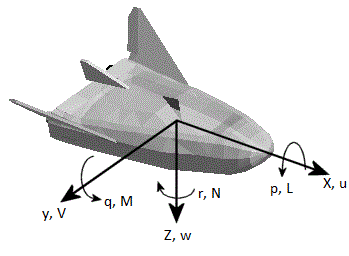Axes and Forces


Help ∨∨∨∨∨∨
Help ∧∧∧∧∧∧
Derivatives are very important, important, and unimportant.
X, Y, Z: Net force in respective direction.
u, v, w: Velocity in respective direction. v can also (and will usually) mean total velocity (u + v + w).
q, p, r: Movement rate in respective direction.
L, M, N: Moment acting on respective axis. L can also mean lift.
α: The angle between the wing and oncoming air.
β: Rotation of the aircraft centerline from the relative wind.
D: Drag.
Y: Sideforce.
M: Mach number.
What are these axes?
What is this "moment" you speak of?

